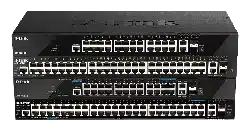Loading ...
Loading ...
Loading ...

DGS-1520 Series Gigabit Ethernet Smart Managed Switch Web UI Reference Guide
373
The fields that can be configured are described below:
Parameter Description
Sequence No.
Enter the ACL rule number here. This value must be between 1 and 65535. Select
Auto Assign to automatically generate an ACL rule number for this entry.
Protocol Type Select the protocol type option here. Options to choose from are TCP, UDP, ICMP,
EIGRP (88), ESP (50), GRE (47), IGMP (2), OSPF (89), PIM (103), VRRP (112),
IP-in-IP (94), PCP (108), Protocol ID, and None.
• Value - The protocol ID can also manually be entered here. The range is
from 0 to 255.
• Mask - After selecting the Protocol ID option, manually enter the protocol
mask value here. The range is from 0x0 to 0xFF.
• Fragments - Select this option to include packet fragment filtering.
The fields that can be configured in Assign rule criteria are described below:
Parameter Description
Source
Select and enter the source information here. Options to choose from are:
• Any - Any source traffic will be evaluated according to the conditions of this
rule.
• Host - Enter the source host IP address here.
• IP - The Wildcard option will be available. Enter the group of source IP
addresses by using a wildcard bitmap. The bit corresponding to the bit value
1 will be ignored. The bit corresponding to the bit value 0 will be checked.
Destination
Select and enter the destination information here. Options to choose from are:
• Any - Any destination traffic will be evaluated according to the conditions of
this rule.
• Host - Enter the destination host IP address here.
• IP - The Wildcard option will be available. Enter the group of destination IP
addresses by using a wildcard bitmap. The bit corresponding to the bit value
1 will be ignored. The bit corresponding to the bit value 0 will be checked.
Source Port
Select and enter the source port value here. Options to choose from are:
• = - The specific selected port number will be used.
• > - All ports greater than the selected port, will be used.
• < - All ports smaller than the selected port, will be used.
• ≠ - All ports, excluding the selected port, will be used.
• Range - The start port number and end port number selected, of the range,
will be used. Alternatively, the port number(s) can manually be entered in
the space(s) provided, if the port number(s) is/are not available in the drop-
down list.
• Mask - The specified source port number and mask will be used. Enter the
source port mask value in the space provided. The range is from 0x0 to
0xFFFF.
This parameter is only available in the protocol type TCP and UDP.
Destination Port
Select and enter the destination port value here. Options to choose from are:
• = - The specific selected port number will be used.
• > - All ports greater than the selected port, will be used.
• < - All ports smaller than the selected port, will be used.
• ≠ - All ports, excluding the selected port, will be used.
• Range - The start port number and end port number selected, of the range,
will be used. Alternatively, the port number(s) can manually be entered in
the space(s) provided, if the port number(s) is/are not available in the drop-
down list.
Loading ...
Loading ...
Loading ...
